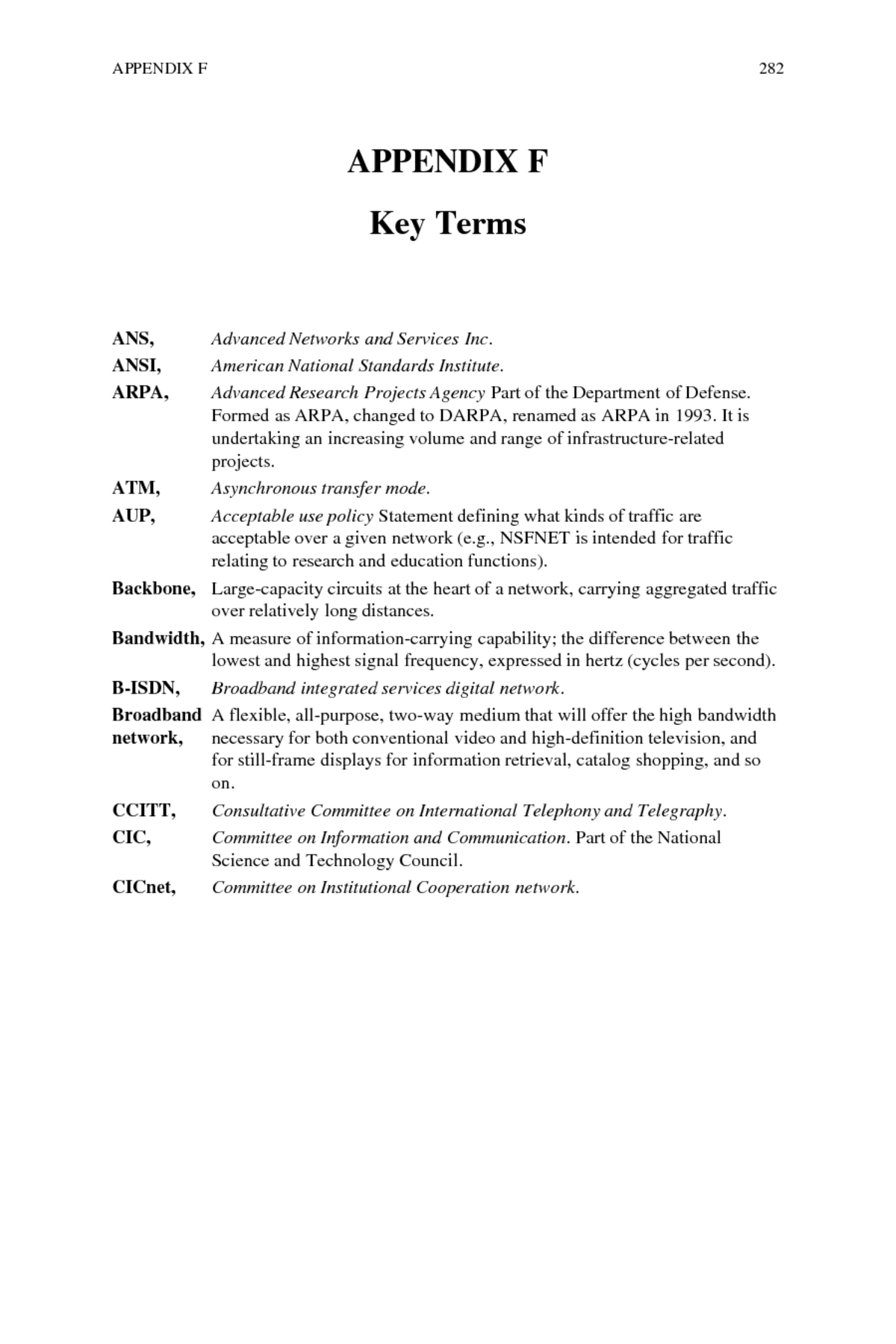Below is the uncorrected machine-read text of this chapter, intended to provide our own search engines and external engines with highly rich, chapter-representative searchable text of each book. Because it is UNCORRECTED material, please consider the following text as a useful but insufficient proxy for the authoritative book pages.
APPENDIX F 282 APPENDIX F Key Terms ANS, Advanced Networks and Services Inc. ANSI, American National Standards Institute. ARPA, Advanced Research Projects Agency Part of the Department of Defense. Formed as ARPA, changed to DARPA, renamed as ARPA in 1993. It is undertaking an increasing volume and range of infrastructure-related projects. ATM, Asynchronous transfer mode. AUP, Acceptable use policy Statement defining what kinds of traffic are acceptable over a given network (e.g., NSFNET is intended for traffic relating to research and education functions). Backbone, Large-capacity circuits at the heart of a network, carrying aggregated traffic over relatively long distances. Bandwidth, A measure of information-carrying capability; the difference between the lowest and highest signal frequency, expressed in hertz (cycles per second). B-ISDN, Broadband integrated services digital network. Broadband A flexible, all-purpose, two-way medium that will offer the high bandwidth network, necessary for both conventional video and high-definition television, and for still-frame displays for information retrieval, catalog shopping, and so on. CCITT, Consultative Committee on International Telephony and Telegraphy. CIC, Committee on Information and Communication. Part of the National Science and Technology Council. CICnet, Committee on Institutional Cooperation network.
APPENDIX F 283 CISE Direc- Computer and Information Science and Engineering Directorate One of the torate, major units of NSF, and the one out of which NSF networking activities are run. CIX, Commercial Internet Exchange A trade association of businesses engaged in providing network services that interconnect with the Internet and/or provide similar services (Alternet, PSI, Sprint, other). Coopera- Form of arrangement between NSF and the providers of NSFNET services. tive agree- Not a standard government procurement; more flexible than a conventional ment, contract for services. ESnet, Wide area network operated by the Department of Energy in support of its research activities. ETC, Entertainment, telephone, and cable television industry complex. FDDI, Fiber Distributed Data Interface. FIX, Federal Internet Exchange A point of interconnection and data exchange among federal agency backbone networks. There are two FIXes, one on each coast. FTP, file transfer protocol Supports file exchange over the Internet. Full-duplex Simultaneous two-way communication, as over the telephone. service, Gigabit A government-industry-academic program for developing and Testbed demonstrating high-speed network technologies. program, HPCA, High-Performance Computing Act 1991 legislation introduced by then- senator Albert Gore to expand and extend on the HPCC (and within it the NREN) vision developed within the Executive Branch. HPCC, High Performance Computing and Communications initiative. HPCCIT, High Performance Computing and Communications Information Technology Subcommittee, under the Office of Science and Technology Policy. IETF, Internet Engineering Task Force. IITA, Information Infrastructure Technology and Applications The new fifth component of the High Performance Computing and Communications initiative. IITF, Information Infrastructure Task Force. ISDN, Integrated services digital network. ISO, International Organization for Standardization. ITU, International Telecommunications Union. LANs, Local area networks. Last mile, Popular term for the ultimate segment of the connection between a communication provider and the customer (usually
APPENDIX F 284 residential but could also be commercial), originating with consideration of the connection between a telephone company central office and the customer premises. Telephone companies typically call that connection the "subscriber loop"; cable television or radio/wireless connections may bear different labels, given their origins as something other than the twisted copper wire pair loop historically typical in telephony. "Access circuit" is another label for the generic concept of connection between a customer or user and the main part of a service provider's network. LATA, Lo- A geographic region ranging from a metropolitan area to a state, created cal access with divestiture of AT&T and used to define service areas for regulated and trans- versus unregulated services (e.g., intra-LATA local services versus inter- port area LATA long-haul services). MANs, Metropolitan area networks. MPEG, Motion Picture Experts Group. NAPs, network access points Elements within the new NSF network architecture for interconnection between the very high speed backbone network service (vBNS) and other network service providers (regional and other mid-level networks, commercial services, and so on). NII, National information infrastructure. NREN, National Research and Education Network A component of the High Performance Computing and Communications initiative. NSFNET, National Science Foundation network. NSI, NASA Science Internet Operated by the National Aeronautics and Space Administration in support of its research activities. NSTC, National Science and Technology Council. NTSC stan- National Television Systems Committee standard for analog transmission of dard, television. OCLC, Online Computer Library Center. ODN, Open Data Network. OSI, Open Systems Interconnection Protocol suite with seven layers promulgated by the International Organization for Standardization. OSTP, Office of Science and Technology Policy. QOS, Quality of service. SONET, Synchronous optical network An international standard for transmitting information over fiber, specifying standardized optical-signal formats and interfaces and integrated into the ATM packet-switching system. TCP/IP, Transmission Control Protocol/Internet Protocol.
APPENDIX F 285 T1 service, 1.5 megabits per second. T3 service, 45 megabits per second. UDP, User Datagram Protocol. vBNS, Very high speed backbone network service The small backbone network NSF plans to introduce in 1994 to replace the larger NSFNET backbone service. WAIS, Wide Area Information Service. WANs, Wide area networks. WWW, World-Wide Web. X.25, A protocol for data transport developed by the International Organization for Standardization as part of the OSI suite.
APPENDIX F 286





